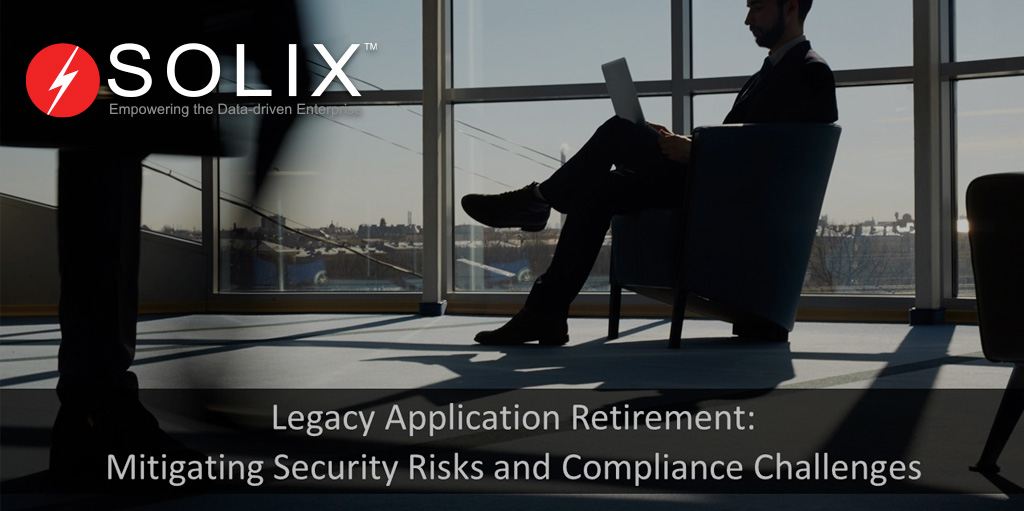
Legacy Application Retirement: Mitigating Security Risks and Compliance Challenges
In today’s digitally connected world, organizations face ever-increasing threats to their data security and an ever-evolving landscape of regulatory requirements. Amidst these challenges, legacy applications—outdated software systems—pose a significant risk. These systems are often riddled with security vulnerabilities, leading to compliance headaches.
This comprehensive blog will dive into the security and compliance risks associated with legacy applications and how retiring them can enhance cybersecurity and regulatory adherence. By understanding the perils of outdated systems and the benefits of retirement, organizations can make informed decisions to safeguard their data and meet regulatory standards effectively.
The Security Vulnerabilities of Legacy Applications
Legacy applications, while functional, tend to be more susceptible to security vulnerabilities than their modern counterparts. Here are some common security risks associated with these outdated systems:
Lack of Updates and Patches
One of the primary issues with legacy applications is the absence of regular updates and patches. Vendors often discontinue support for older software versions, leaving organizations vulnerable to known security flaws. Attackers actively exploit these vulnerabilities to gain unauthorized access to systems and data.
Inadequate Authentication and Authorization
Many legacy applications were developed at a time when security concerns were not as pronounced. They may lack modern authentication and authorization mechanisms, making it easier for unauthorized users to gain access. Weak or static passwords can be easily cracked, compromising the system’s integrity.
Outdated Encryption Standards
Data encryption is a fundamental component of cybersecurity. Legacy applications often use outdated encryption standards, which are no longer considered secure against modern attack methods. This puts sensitive data at risk of being intercepted or compromised during transmission.
Poorly Documented Code
Legacy applications may have poorly documented or outdated code, making identifying and rectifying security vulnerabilities challenging. This lack of transparency can hinder efforts to secure the application effectively.
Compatibility Issues
Modern security tools and practices may not be compatible with legacy applications, limiting the organization’s ability to implement robust security measures. This can create gaps in the overall security posture.
The Compliance Challenges of Legacy Systems
In addition to security risks, legacy applications can present significant compliance challenges. Here’s how outdated systems can impact regulatory adherence:
Data Privacy Regulations
Many countries and regions have introduced stringent data privacy regulations, such as Europe’s General Data Protection Regulation (GDPR). Legacy systems may not have been designed with these regulations in mind, making it difficult to manage and protect sensitive customer data as required by law.
Data Retention and Archiving
Certain industries and regulatory bodies require organizations to maintain records for a specified period. Legacy systems may not have effective archiving mechanisms, making it challenging to retain and retrieve data in compliance with retention policies.
Audit Trails and Reporting
Modern compliance standards often demand robust audit trails and reporting capabilities to track user activity and system changes. Legacy applications may lack these features, making it challenging to demonstrate compliance during audits.
Security Standards
Security standards and best practices evolve over time to address emerging threats. Legacy systems may not meet current security standards, leaving organizations out of compliance with industry-specific security requirements.
The Benefits of Legacy Application Retirement
Given the security vulnerabilities and compliance challenges associated with legacy applications, retiring them is a strategic imperative. Here’s how retiring legacy applications can enhance cybersecurity and regulatory adherence:
Elimination of Vulnerabilities
Retiring legacy applications removes the primary source of security vulnerabilities. With no legacy system to exploit, attackers lose a potential entry point into the organization’s network and data.
Transition to Modern Platforms
When retiring legacy applications, organizations typically migrate to modern platforms and technologies. These modern systems are designed with security in mind, incorporating the latest encryption standards, authentication mechanisms, and security updates.
Improved Data Management
Modern systems often come equipped with robust data management and archiving capabilities. This enables organizations to more effectively meet data retention requirements and respond to data access requests in compliance with privacy regulations.
Enhanced Reporting and Audit Trails
Modern systems offer improved reporting and auditing features, making tracking user activity and system changes easier. This transparency facilitates compliance with regulatory requirements and simplifies the audit process.
Alignment with Security Standards
Retiring legacy applications allows organizations to align with current security standards and best practices. This ensures that security measures are up to date-and capable of mitigating modern threats effectively.
The Retirement Process
Retiring legacy applications is not a simple task, but it is necessary for organizations looking to enhance security and compliance. Here are the key steps involved in the retirement process:
Assessment and Inventory
Begin by conducting a thorough assessment of all legacy applications in use. Identify which ones pose the greatest security and compliance risks.
Risk Mitigation
Develop a plan to mitigate the identified risks while the legacy applications are still in use. This may involve applying security patches, enhancing access controls, or implementing additional security measures.
Data Migration
Plan and execute the migration of data from legacy systems to modern platforms. Ensure data integrity, accuracy, and accessibility during and after the migration.
Testing and Validation
Thoroughly test the new systems and security measures to ensure they meet security and compliance requirements. Identify and address any issues or vulnerabilities that arise during testing.
Training and Communication
Provide training to employees on the use of the new systems and security protocols. Ensure clear communication about the retirement process and its benefits for security and compliance.
Retirement and Decommissioning
Once the new systems are in place and validated, retire the legacy applications. Decommissioning should include the secure disposal or archiving of any data and systems that are no longer needed.
Ongoing Monitoring and Maintenance
Continuously monitor the new systems for security and compliance. Regularly update security measures to address emerging threats and evolving regulatory requirements.
Legacy application retirement is critical in enhancing cybersecurity and ensuring regulatory adherence in today’s data-driven and highly regulated business environment. Outdated systems pose security vulnerabilities and compliance challenges that can put organizations at risk of data breaches, fines, and reputational damage. Organizations can mitigate these risks by retiring legacy applications and migrating to modern, secure, compliant systems, improving their overall security posture, and streamlining compliance efforts. It is a strategic move that protects sensitive data and positions organizations to thrive in a rapidly changing digital landscape.



